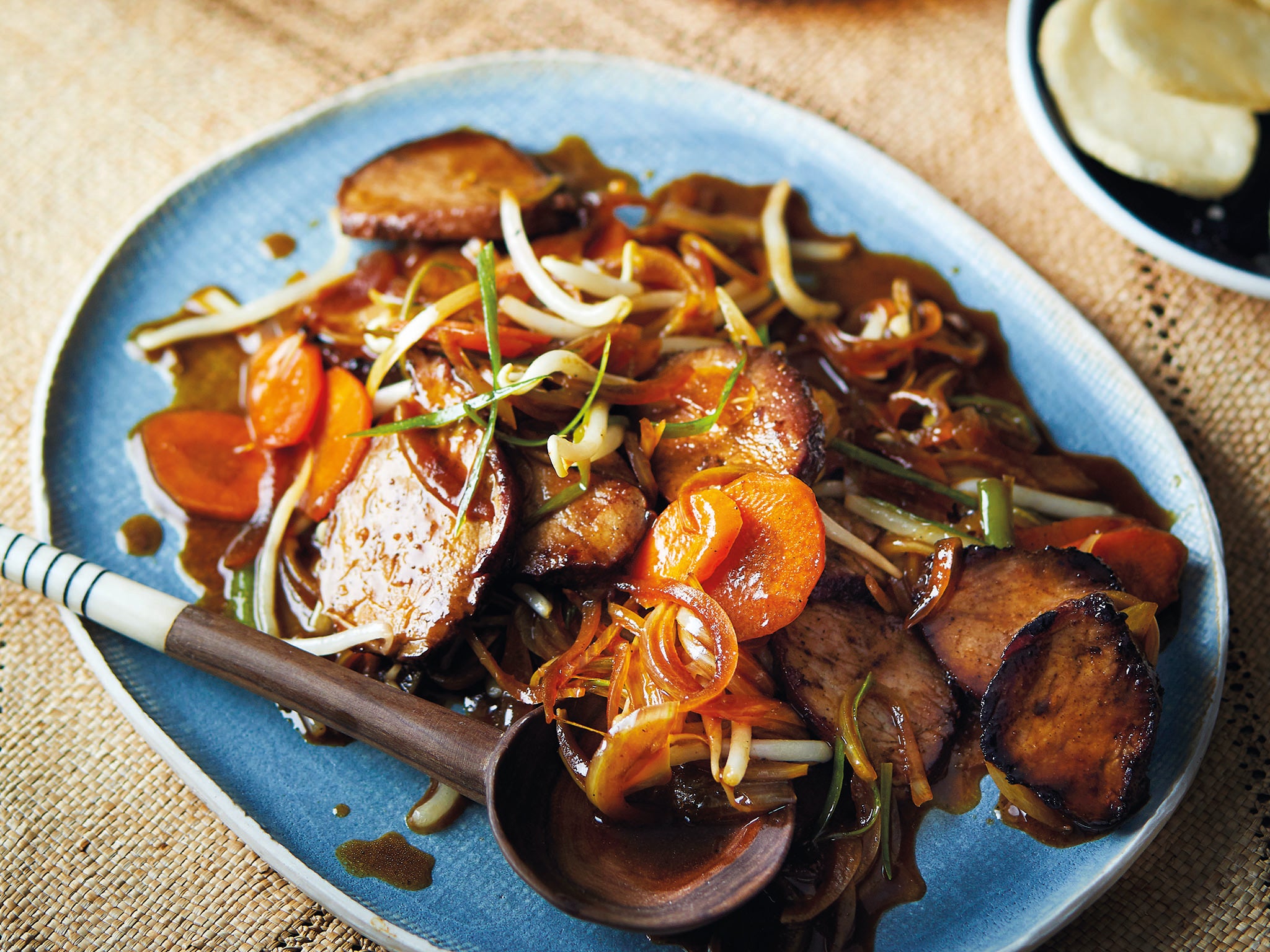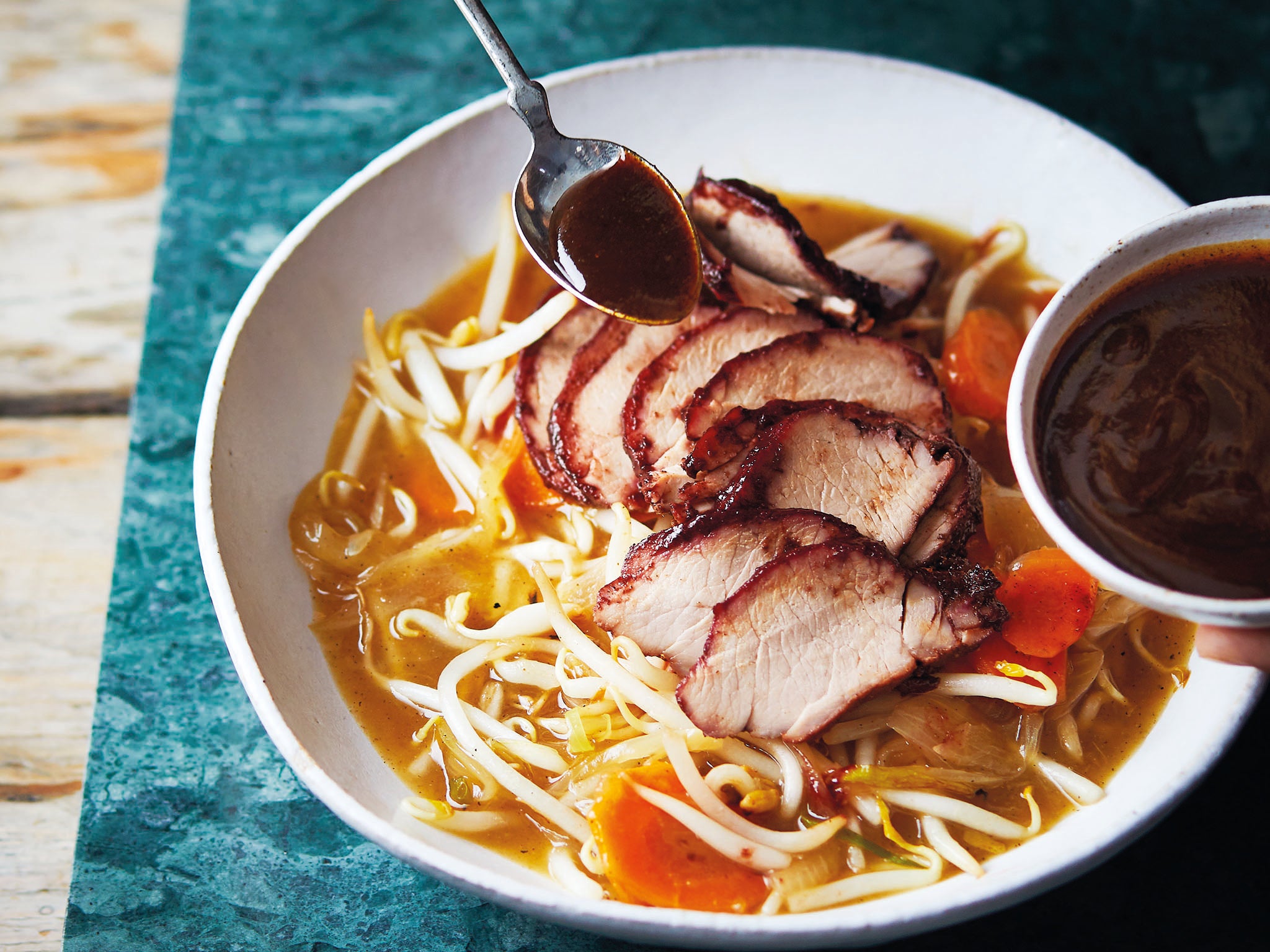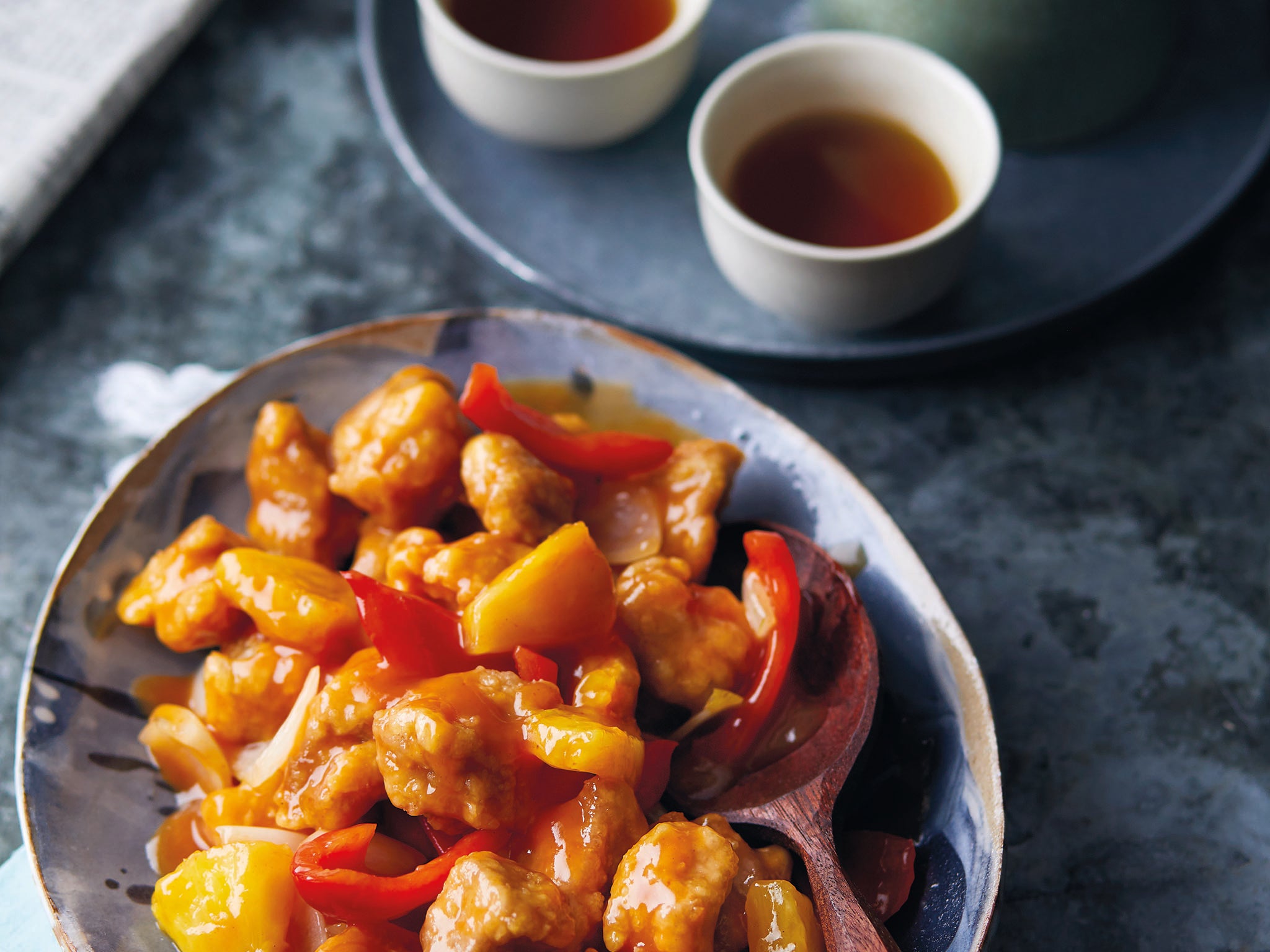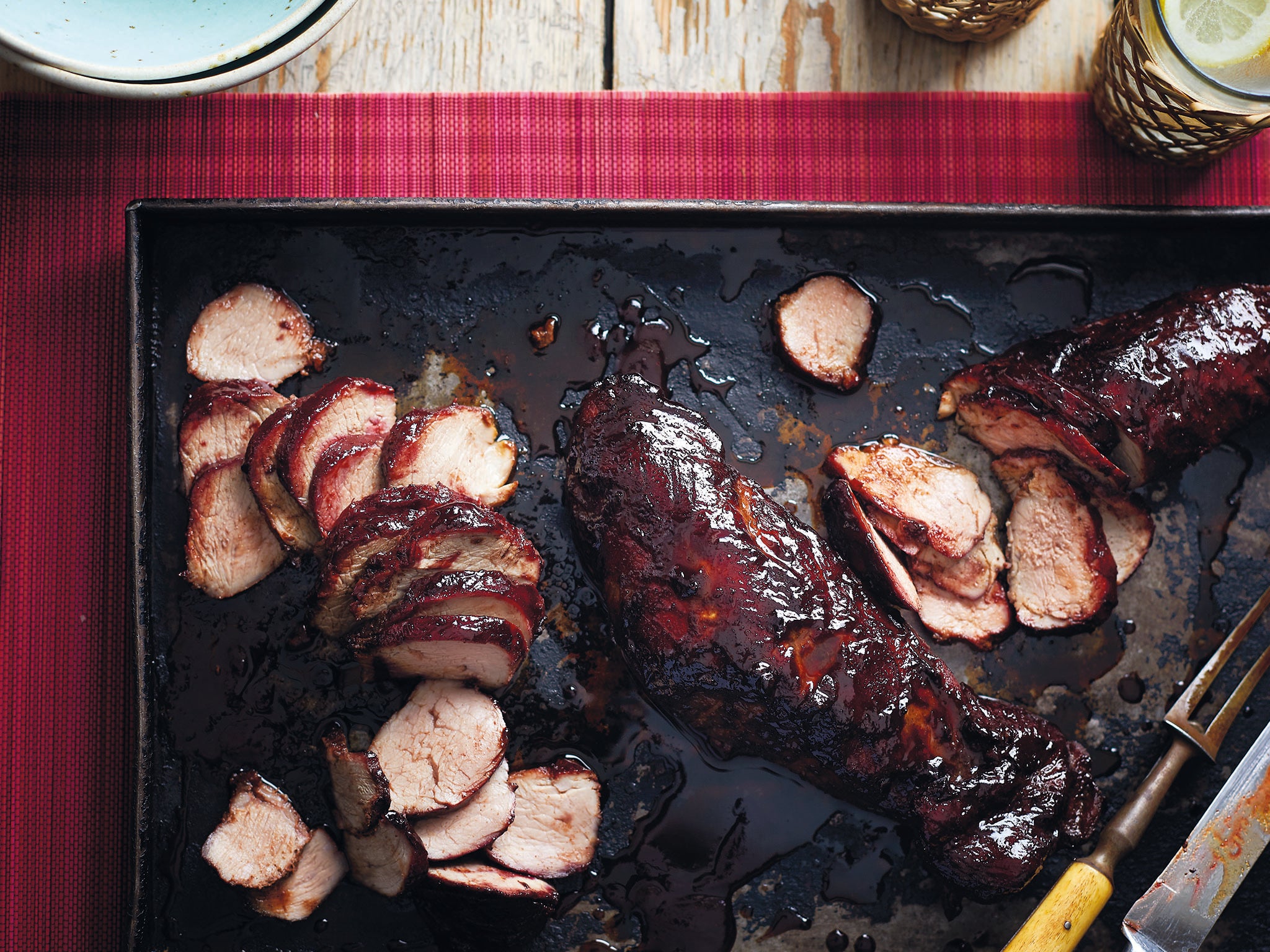'Chinese Takeaway Cookbook': Recipes from chop suey to sweet and sour pork
2019 is the year of the pig, and to celebrate recreate some of Kwoklyn Wan's dishes you'll know and love from your favourite takeaway

Chinese roast pork – Chop suey
There are many stories of the origin of the humble chop suey. One account claims it was invented by a Chinese American working on the Transcontinental Railroad in the 19th century. Created wherever and by whoever, you’ll most likely find this dish on every Chinese restaurant menu. The pinch of pepper is essential as it totally changes the flavour of the dish.
1 tbsp groundnut oil
200g (7oz) Chinese roast BBQ pork (see below *)
1 small onion, thinly sliced
2 handfuls of beansprouts
1 small carrot, sliced into slivers
a pinch of salt
a pinch of granulated sugar
60ml (¼ cup) water
2 spring onions (scallions), halved and sliced into slivers
½ tbsp dark soy sauce
a pinch of white pepper
1 tbsp cornflour (cornstarch) mixed with 2 tbsp water
1 tsp sesame oil
Heat the oil in a non-stick wok and fry the pork for 2 minutes. Add the onion and stir-fry for a further minute, then add the beansprouts, carrot, salt, sugar and water and bring to the boil.
Now add the spring onions, soy sauce and white pepper and mix thoroughly – ensure the heat is high. Check the seasoning and adjust if necessary.
Pour in just enough of the cornflour mixture to thicken the sauce, stirring the ingredients the entire time. Remove from the heat, stir in the sesame oil and serve straightaway.

Char siu pork, beansprouts and bbq sauce
Chinese BBQ pork (char siu) is famous the world over – marinated in spices, the meat takes on a distinct dark red colour as it cooks. Served over beansprouts with a rich Chinese BBQ sauce, this dish will soon become one of your all-time favourites.
400g (14oz) piece of Chinese BBQ pork (see below *)
1 tbsp groundnut oil
2 spring onions (scallions), halved and sliced into slivers
1 garlic clove, crushed
1 small onion, thinly sliced
1 small carrot, thinly sliced
3 handfuls of beansprouts
2 tbsp oyster sauce
¼ tsp salt
½ tsp sugar
½ tsp white pepper
120ml (½ cup) chicken stock
1 tbsp cornflour (cornstarch) mixed with 2 tbsp water
1 tsp sesame oil
For the BBQ sauce
2 tbsp Chinese five spice
240ml (1 cup) chicken stock
2 tbsp rice wine
120ml (½ cup) hoisin sauce
120ml (½ cup) yellow bean sauce
2 star anise
1 cinnamon stick
50g (¼ cup) sugar
3 tbsp cornflour (cornstarch) mixed with 6 tbsp water
Preheat the oven to 160°C (325°F) and reheat the pork in a shallow baking tray for 20 minutes. Remove from the oven and cut into slices. Meanwhile, put all of the BBQ sauce ingredients, except the cornflour mixture, in a medium saucepan, stir together and gently bring to the boil. Lower the heat and simmer for 15 minutes.
Slowly stir the cornflour mixture into the sauce to thicken. Remove the star anise and cinnamon stick and set to one side.
Heat a non-stick wok over a medium heat, add the oil, spring onions and garlic and stir-fry for about 30 seconds, until fragrant.
Add the onion and carrot and stir-fry for a further minute. Add the beansprouts and fry for another minute, then add the oyster sauce, salt, sugar and white pepper. Mix well, pour in the chicken stock and bring to the boil. Once boiling, slowly pour the cornflour mixture into the pan, stirring continuously, to thicken the sauce.
Remove from the heat, stir in the sesame oil and transfer to a serving plate. Arrange the sliced pork over the top, drizzle with BBQ sauce and serve.

Cantonese style sweet and sour pork
"Life is a pair of chopsticks, serving us sweet, sour, bitter and spicy. Where possible let's make life sweet." The original sweet and sour sauce originated in the province of Hunan, China. The sauce was a light vinegar and sugar mixture with very little resemblance to the bright orange dish served in many restaurants today.
groundnut oil for frying
300g (10½oz) pork loin, chopped into 2cm (¾in) cubes
1 egg, beaten
¼ tsp salt
50g (½ cup) cornflour (cornstarch)
For the sweet and sour sauce
240ml (1 cup) orange juice
2 tbsp sugar
1 tbsp tomato purée
1 tbsp tomato ketchup
3 tbsp white wine vinegar
½ red (bell) pepper, de-seeded and roughly chopped
½ small onion, roughly chopped ,a handful of pineapple chunks (fresh or tinned)
3 tbsp cornflour (cornstarch) mixed
with 6 tbsp water
Put all the sauce ingredients, except the cornflour mixture, into a large saucepan over a medium heat. Bring to the boil, lower the heat and simmer for 5 minutes. Slowly stir the cornflour mixture into the sauce a little at a time, stirring continuously, until you have the desired consistency. The sauce should be thick enough to coat the back of a spoon. Leave to one side.
Heat enough oil in a large saucepan for the pork nuggets to float without touching the bottom of the pan, to 170°C (340°F).
Place the pork loin in a large bowl, add the beaten egg and salt and mix well, ensuring all the pork is coated in egg. Tip the cornflour into a separate bowl then add the pork and stir to coat in cornflour, shaking off any excess. Gently lower the coated pork pieces into the oil and fry for around 5 minutes, or until completely cooked. (If you have a food thermometer probe, the internal temperature should be 75°C/170°F.) Remove the pork and drain on a wire rack or a plate lined with kitchen paper.
Arrange the pork on a plate, spoon over your sweet and sour sauce and serve.

* Chinese roast BBQ pork
In Hong Kong, char siu is usually purchased from a Siu Mei establishment, which specialises in meat dishes – char siu (BBQ pork), soy-sauce chicken, roast goose, crispy belly pork. These shops usually display their merchandise by hanging them in the window and, as a result, char siu is often eaten with one of these other meat dishes in a ‘rice box’ meal.
800g (1lb 12oz) pork shoulder or loin
1 tbsp Chinese five spice
2 tbsp Chinese rice wine
2 slices of fresh ginger
2 garlic cloves, crushed
3 tbsp yellow bean sauce
3 tbsp hoisin sauce
3 tbsp white sugar
2 star anise
1 cinnamon stick
1 tbsp honey, plus 2 tbsp mixed
with 2 tbsp hot water for glazing
Put the pork into a large bowl, add the remaining ingredients (except the honey-water glaze) and massage the ingredients into the pork. Cover, transfer to the fridge and leave to marinate for at least 2 hours or overnight.
The next day, remove the pork from the fridge and allow to come back up to room temperature. Preheat the oven to 180°C (350°F). Sit the pork on a baking tray (reserving the marinade separately), cover in foil and cook in the oven for 20 minutes. Turn and baste with marinade, then cook for a further 10 minutes, covered. Check the pork is cooked by inserting a skewer to ensure the juices run clear.

Baste the pork with the marinade for a second time and return to the oven to cook, uncovered, for a further 20 minutes. You want the pork to be a deep amber colour and the marinade should be sticky and dry.
Remove the pork from the oven and brush with the honey and water mixture to glaze, then flash under the grill for 2–3 minutes or until the edges have scorched. Leave the pork to cool to room temperature, then slice and serve.
'The Chinese Takeaway Cookbook' by Kwoklyn Wan (Quadrille £15) Photography: Sam Folan
Join our commenting forum
Join thought-provoking conversations, follow other Independent readers and see their replies
Comments